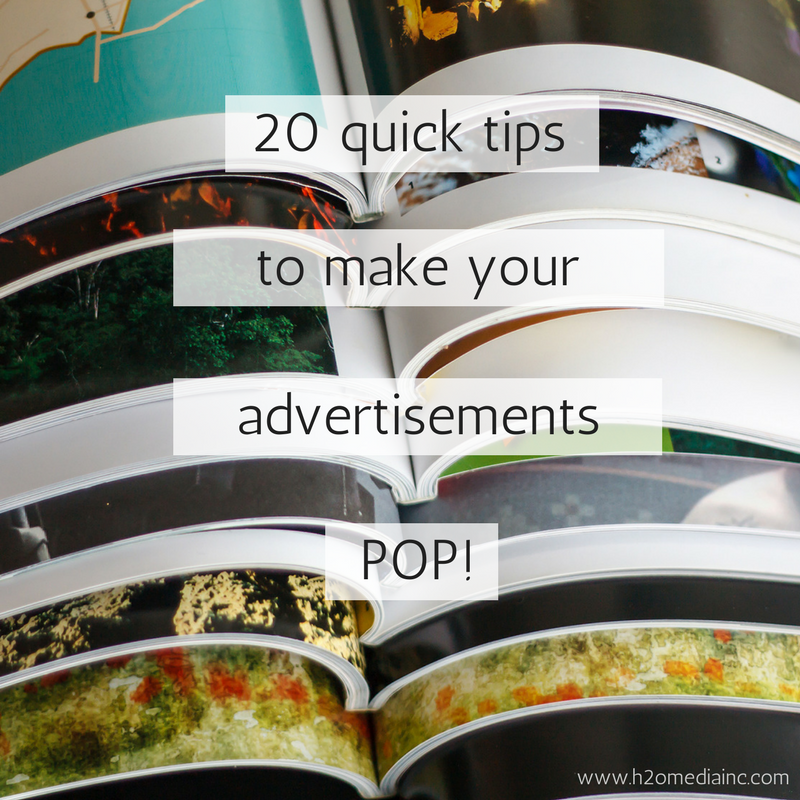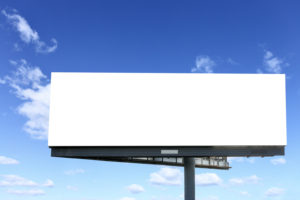
20 Tips to Make Your Advertisements POP!
Marketing experts estimate the average American is exposed to between 4,000 to 10,000 advertisements each day. Each day! That number might sound a little crazy at first, but think about all the ads you see every time you scroll through social media, walk through the grocery store or even just drive down the highway. Advertisements are everywhere, but would you believe that we only actually notice about 100 of those 10,000 advertisements? That’s right. Our brains block out over 90 percent of the advertisements we “see” every day. This is why you need great advertising.
Consumers are bombarded with an enormous number of ads every day. To really stand out, your advertisements need to be truly catchy, clever and unforgettable. Here are 20 tips to help you create advertisements that will catch consumers’ attention, even in the sea of ads.
1. Use color wisely
Picking a color scheme for your advertising seems so easy. Just go with the colors in your logo, or pick something bright, right? Well, it’s actually not that simple.
Color, although often overlooked, has the ability to greatly influence customers psychologically. For example, black might seem like a classy, elegant color choice to you, but many consumers associate black with death, evil and mystery. That’s probably not what you want people to think about when they look at your ads. So before you choose a color palatte for your next ad campaign, do a little research into how consumers feel about different colors.
2. Write great copy
Colors catch the consumers’ eye, but good copy pulls them in. You don’t need to write a novel describing your product, but make sure your advertisement contains a bit of well-written copy that tells the consumer what you can do for him/her.
If you need a little help writing copy that sells, take a few tips from one of advertising’s best.
3. Fonts matter
Have you ever seen a billboard written in calligraphy? Or an advertisement on a taxi cab written in cursive? No, probably not. That’s because those advertisements would be impossible to read while driving down the street. Instead, these sorts of ads are typically written in big, bold, block letters. Easy to see, even at 65 miles per hour. The same theory applies to magazine and digital advertising. When consumers are flipping or scrolling through pages quickly, you need to catch their attention with something that’s fast and easy to read. No fancy letters. No elegant script. Helvetica might not seem all that exciting, but trust us. It’ll get the message across.
4. Build a strong headline
Now that you’ve picked the perfect, eye-catching font, use it to write the perfect, eye-catching headline. Easier said than done, we know. But you can start by keeping it simple, short and clear. This isn’t the place for long paragraphs describing your product or company. You can do that in the copy.
5. Use emotion
Emotion is what catches people’s attention. It’s what makes them look twice, stop and think. Happy, scared, joyful, angry — the emotion doesn’t matter, just as long as the consumer feels some sort of emotional response. The consumer might not remember your exact ad, but he will remember the way it made him feel, and that’s just as powerful. Take a look at some of these advertisements for inspiration.
6. Be clear
Creative advertisements are great, but there’s one thing more important that creativity: clarity. Consumers don’t want to be confused when they view your ads; consumers want to know what you’re selling. What is your product all about? What does it do? Who is it for? Be clear, and give your consumers the answers the want.
7. Stay simple
Clarity and simplicity go hand in hand. An advertisement with tons of bright colors, big letters, crazy designs and glitter might sound great, but it’s probably just going to drive consumers away. Focus on what your product does, and that’s it. If what you’re selling is really, truly great, your advertisements won’t need bells and whistles to be successful.
8. Be specific
What problem does your product solve? Why is your product special? Your advertisements should answer these questions either with text or images. If you want consumers to choose your product over many similar choices, give them a good reason to pick you.
9. Show your brand

Your brand is one of your most valuable assets. Make sure consumers can recognize who you are in your advertisements.
If you see a bullseye, you think of Target. If you see Clydesdales, you think of Budweiser. These are examples of great branding. In your advertisements, you want to showcase your brand. Include your logo on everything you create. You want consumers to immediately be able to recognize your brand, company and products.
10. Use a call to action
Don’t just show consumers your advertisements; tell them to make a purchase. Use a call to action like “get your free sample,” or “try risk-free for 30 days.” This will encourage consumers to make a move after seeing your ads.
11. Make your visuals relevant
Make sure your visuals relate to what you’re trying to sell. If your product is a protein bar, your advertisement should probably contain a photo of a protein bar. I’ve seen far too many ads where the product being sold is something completely different than what the image shows. This only confuses the consumer. There’s a fine line between creativity and just being irrelevant.
12. Use humor
David Ogilvy once said that “the best ideas come as jokes. Make your thinking as funny as possible.”
That’s some pretty good advertising advice. Everyone loves a good laugh, so make your consumers chuckle, and they’ll start associating your product with feeling happy.
13. Quality over quantity
Frequency is incredibly important in advertising, but quality is king. You’d rather have three really great ads with clear, creative pictures, great copy and a catchy headline than 40 ads with blurry photos, lackluster copy and no headline.
14. Be original
Don’t copy others’ work. It’s as simple as that. Create your own great advertisements without taking others’ ideas.
15. Go big
Advertising isn’t the place to be quiet and reserved. To make your ads truly pop, you need to go big. Big letters, big visuals, big spaces.
16. Take it outside
Speaking of big spaces, outdoor advertising can be a great way to make your ads look larger than life. Switch up your print and digital advertising, and take things outside. An advertising agency can typically provide you with reasonable prices for anything from billboards to transit ads (think taxicabs and busses).
17. Make it shareable
This applies to your business’s social media as well as its advertising. If you make your content shareable, consumers are going to show it to friends and family. This is going to create more consumers. Think of the Super Bowl. If people like your ads, they’re going to share them, and you’ll end up with more eyes on your product.
18. Make it personal
To make sure your advertising is shareable, try making it personal. Appeal to emotions, or focus on something you know your target audience can relate to. For example, if you know your target audience is women ages 35-40, address a problem you know this group suffers from and how your product specifically can fix it.
19. Test
You may think your advertisements are great, but your audience may disagree. Make sure to test your ads constantly to see how they are performing. Does your audience like advertisement A better than advertisement B? Is your advertisement on this website performing better than that website? Do more of what’s working, and less of what isn’t. Never stop testing; never stop improving.
20. Repeat
In the world of advertising, frequency is the one word you really need to remember. One advertisement is never enough, no matter how great that ad might be. Once you create a great advertisement, you need to test to see how it’s received by your audience. Then make changes, and repeat the process all over again.


